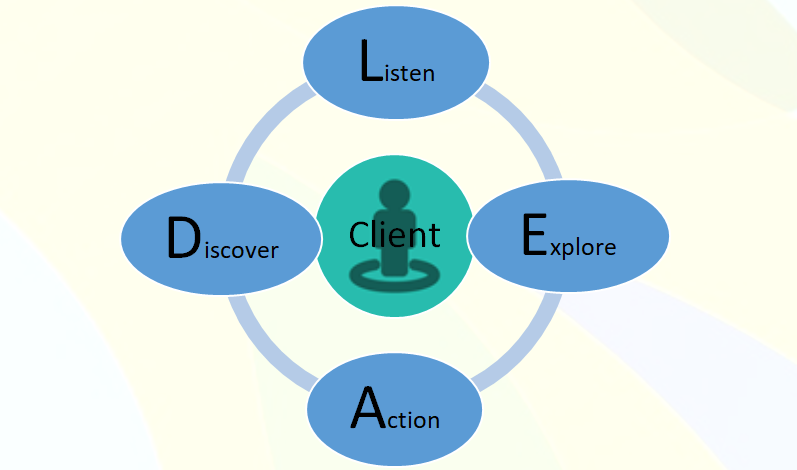A Coaching Model Created by Holly Deanna Thede
(Leadership and Life Coach, CANADA)

The Client
As you can see in the LEAD model, the client holds centre stage. This is because the client is the sole contributor to the coaching process. The inner circle between the client and the process resembles the individual determinants of behaviours; beliefs, values, experiences, intuition and internal/external influences with regards to emotional, mental, spiritual and physical structures.
Within the coaching relationship, these individual determinants and structures are important to discover with your client, as these are “windows” into who they are, and what is driving them. We can discover these insights with our powerful listening and powerful questioning. We can invite our clients in performing exercises to open these windows, whether this is a deeper understanding of their learning style, individual strengths or insights on the various roles they play in their daily lives. The coach can offer such awareness practices in the very beginning of a coaching relationship, or anywhere in between.
The client is represented in the centre as a constant reminder that we must always have a presence with our client. The coaching presence must be established and maintained throughout every coaching session. Building a trusting and intimate relationship is necessary for your client’s success.
Listen
Listen with the intent to understand, not reply. This initial stage of the process is where we listen to the client’s story in the search for intention. Silence and space need to be demonstrated by the coach in order for the client to express all that is valuable to them. The coach engages in active listening, more specifically listening for clues: the determinants of behaviour. These are the “hidden jewels” in the client’s story. As coaches, we raise our senses, our antennas, our emotional intelligence, by paying close attention to the language and the emotions that the client is demonstrating; trusting ourselves to pick up what the client is saying and not saying. Upon recognizing these clues, we can then form questions, observations and reflections that are more meaningful for the client, creating insight and clarity.
The coaching agreement is in full force in this stage. Discovering an intention, the meaning and the path are all necessary for moving forward. This can be complex for a coach, as the intention can shift many times with the client. However, before the coach moves forward to explore the intention, there should never be ambiguity surrounding what the intention is. It must be clear!
Explore
Once the coach uncovers the client’s true intention, the exploration begins! Here, the coach moves into exploring the details of the intention more deeply by using a combination of powerful listening and powerful questioning. The power tools will provide a great tool to assist the coaching delving deeper into the determinants of behaviour, discovering what is holding the client back. As previously discussed, this would be any one or more of the determinants of behaviour; beliefs, underlying values, perspectives etc. Once the coach uncovers what is holding the client back, more challenging questions will create a deeper understanding of the held perspective, and both parties will gain insight into what is getting in the way. When a coach discovers this, then the client can be challenged on these limited perspectives or beliefs. The result of the challenge will leave the client in a position to accept and move forward, or dig deeper; either way, we are having the client create an action, big or small, to provide a result that is desirable. It is somewhat common that in this stage of exploration, a coach may need to redirect our client back to their original intention to remain focused. The coach’s role is to hold the client accountable to the focus and direction of the conversation.
Action
The client should always be accountable to set the action. It is common knowledge that when others set goals for us, we are not as accountable to them. Having the client take ownership of setting their own action is done to not only provide accountability but to also provide a sense of ownership and empowerment for the client. Using SMART goals is a great way to have the client strategically think through the value and desire of their set goal. Here, the coach must question any possible barriers, what could get in the way of achieving this goal? Options of uncovering this could be the application of scales to measure the goal commitment or a vision exercise that will assist the client in painting a picture of what the action and the achievement may look like and feel like.
Specific-What is the exact action that needs to take place?
Measurable-How will you know when you achieve this?
Achievable-Is this realistic and do you have the supports?
Relevant-Is this meaningful and do you have the desire?
Timely-What is the timeline to achieve this goal?
Discovery
The coach and the client will discuss if the results of the action aligned with the intention and the goal. The coach explores the action in detail and poses inquisitive questions to have the client explore what worked well and/or what did not. On one hand, if the goal was achieved, what made it work well? On the other hand, if the goal was not achieved, what needs to be done differently to ensure the goal is met? The coach must always be sure to acknowledge the client for their efforts, through reflection and feedback. The coach will ask questions that will have the client evaluate their actions, thus create insight. Lastly, what did our client learn about themselves through this process? This step is imperative in helping the client achieve accountability, self-awareness and empowerment. Following up with the client is an essential step in the coaching process, and we must remember as a coach, we are not responsible for the client’s success, the client is!
<<Find out more about how to create your own Coaching model at ICA>>